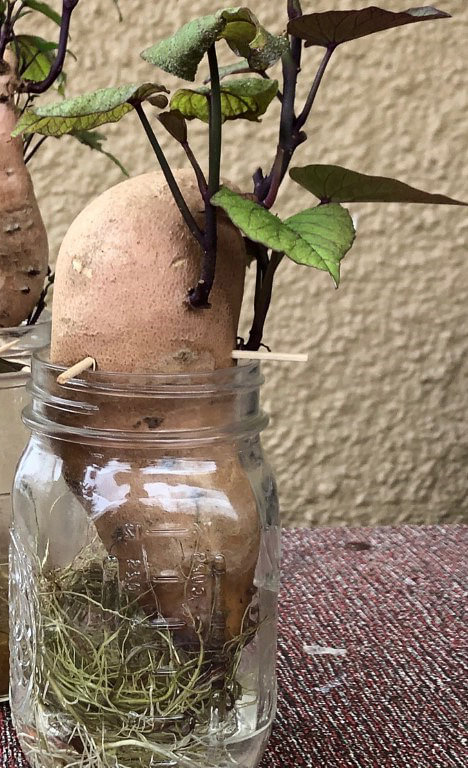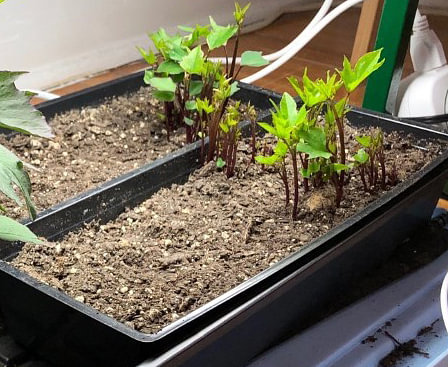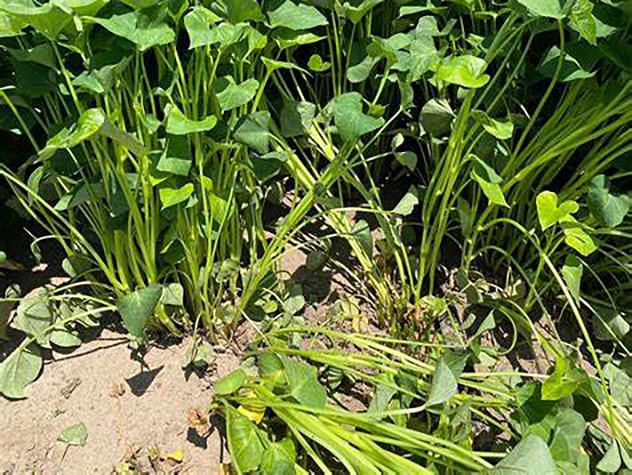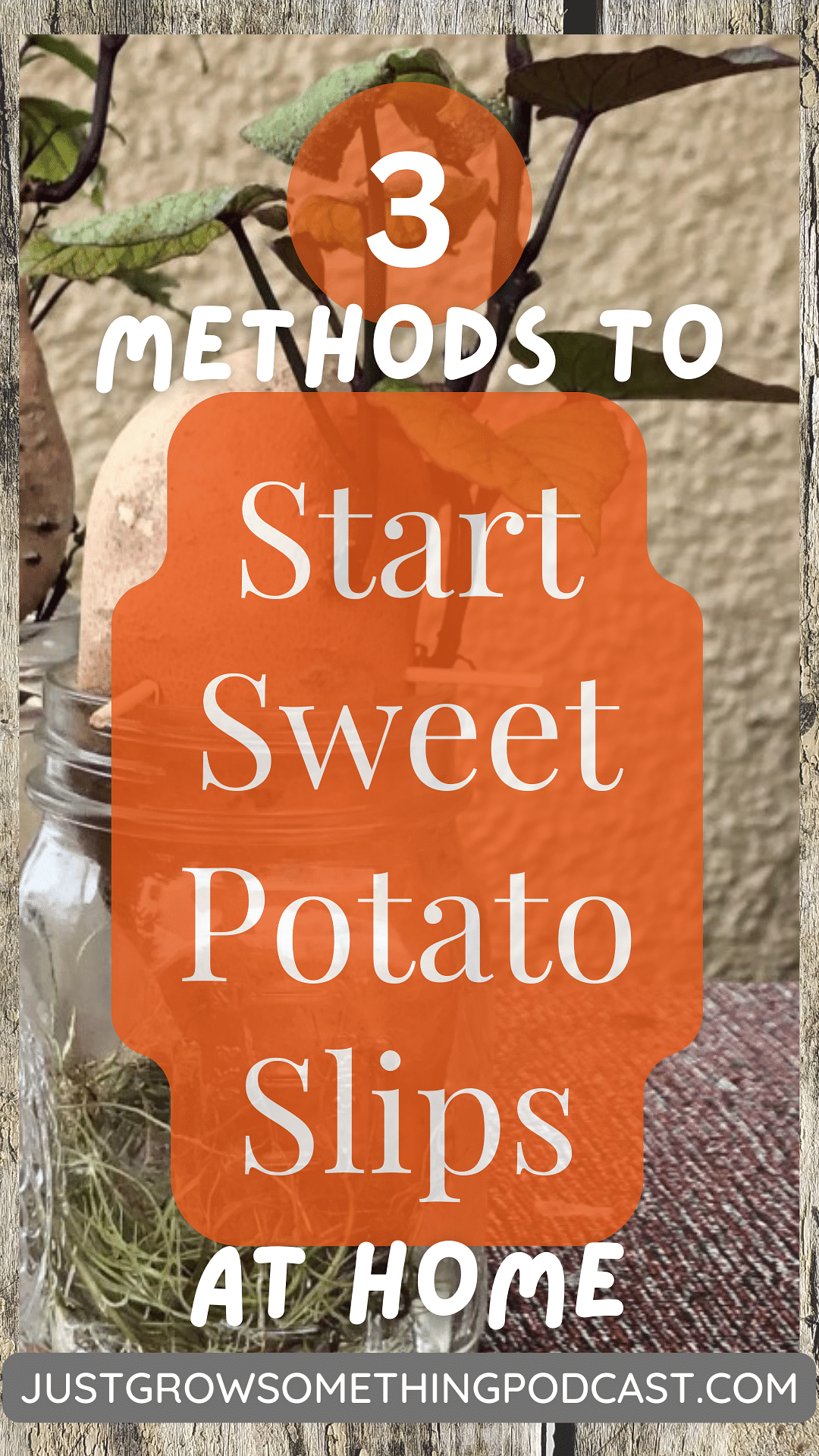
There are three different ways we can easily get our own sweet potato slips started either from our own harvested sweet potatoes or from store-bought ones to plant for a new crop in our garden this year. It’s easier than you think and even if you need a lot of slips, it takes up less room than you might think.
What Are Sweet Potato Slips?

If you’ve not grown sweet potatoes before you may not know that growing them is different from growing a regular Irish potato. Irish potatoes are grown from a piece of a potato with sprouting points we call eyes that are placed in the ground and covered with soil. The eyes sprout the shoots that grow above ground which sends energy back down into the tuber below ground, which then sends out roots which grow new tubers on them and those become the new potatoes that we harvest.
Sweet potatoes are grown from slips. Essentially, these are shoots that have sprouted from a mature sweet potato that are then removed and allowed to root, then planted in a mound of soil about eight inches high. It can take a few weeks for your slips to get established but after that the shoots will take off, continue to grow and sprawl, sending energy to the roots, which then produces the new tubers. Sweet potatoes are in the morning glory family, so you’ll see the shoots become vines, and those vines will take off and ultimately cover the exposed soil in the garden bed and choke out anything else that attempts to grow there. They also put out those distinctive funnel-shaped flowers indicative of most plants in the Convolvulaceae family.
So, how do we get these slips so we can grow our own crop of sweet potatoes? There are three main ways you can start slips from sweet potatoes you have on hand, whether they were from last season’s harvest, from a neighbor or the farmer’s market, or even from the grocery store: there’s the water method, the container method, and the in-ground method. There are pros and cons to each and which one you choose will depend on how much space you have, how long your growing season is, and whether or not you have things like lights or heat mats indoors to help facilitate some of these things.
The Water Method

All you need to start sweet potato slips in water is a mason jar, toothpicks, water and your potato. You need to determine the rooting end of your sweet potato. Generally speaking the rooting end is the skinnier or more slender end of the sweet potato and if you wash it well and look really closely, you may already see tiny little roots emerging from a potato that’s been stored at room temperature. The opposite end is the sprouting end, the side that will produce our slips for us.
Put your sweet potato about halfway into your mason jar with the rooting end down and then push the toothpicks into the sides of the potato so they extend out over the lip of the jar to suspend the potato in place. Then you’ll add fresh water to the jar so the bottom half of the sweet potato is submerged and the sprouting end is above the jar.
You can now put the jar either in a sunny window where it gets some warmth and some light or another warm spot, like the top of a refrigerator or on a seedling heat mat if you have one. If it’s not in a window, you’ll need to supply some artificial light but it doesn’t need to be fancy. Just enough light to encourage growth once the shoots start to sprout.
Refresh the water when needed to keep the water level up, replacing it completely once a week to be sure the water doesn’t get funky and cause the bottom of the potato to root before forming roots. After a few weeks, you’ll start to see the potato start to pull roots at the bottom and then the sprouts will start to form at the top. These sprouts are your slips! Let them get about six inches tall before removing to plant them.
This water method is pretty simple and straightforward but if you need a lot of slips it may take up more room than what you have. You might not want a bunch of mason jars with sweet potatoes sticking out of them sitting all over your house for weeks on end. This also the slowest method for sprouting them, generally taking a minimum of six weeks, sometimes as long as 10 weeks, depending on how warm you keep your jars.
The Container Method

The next method we can use is the container method. This method is much faster and you can get a lot of slips from a pretty small space. But, you’re going to need some artificial lighting for this and, ideally, a seedling heat mat plus a place you don’t mind having a tub full of soil and potatoes sitting for a six to eight weeks.
For this method you’ll need a shallow container, potting soil or seed starting mix, a seedling heat mat, and some artificial lighting.
For sprouting just a few sweet potatoes the container you use can be something like a foil baking pan or a deep seedling tray. Really, any shallow container that can have drainage holes but that can also have something placed beneath it to catch water will work. The size is really up to you and how many sweet potatoes you want to sprout and how much room you have to do it.
Create drainage holes in the bottom of your container and put a layer of potting soil or seed starting mix into the container about two inches deep. Nestle your sweet potatoes into the soil, laying them flat, and then fill in with more soil around the potatoes until they’re covered at least halfway up. The reason we do it this way instead of completely burying them is to prevent the potatoes from rotting before they get a chance to root and sprout. You may also choose to completely cover them very lightly with the potting soil. Put your container on top of something to catch the water, so the lid to the baking sheet if that’s what your using or another larger container if you’re using something else, and then water the soil thoroughly. We don’t want it sopping wet, but you’ll want to keep the soil moist as the roots begin to form. Put the container on top of the heat mat if you have one, which I highly recommend because it definitely makes this process go faster. The sooner you can get the sweet potato to form roots the lower the chances that you’ll have any of the tubers begin to rot. With heat, it should take about a week for the roots to form and then about another week or so to start seeing sprouts. Much faster than the water method. At this point be sure you give the sprouts some light, similar to growing seedlings indoors. Let them get to be about six inches tall before removing for planting.
The In-Ground Method

Our final method for sprouting sweet potato slips is similar to the container method and that’s the in-ground method. We’ll be doing this out in our garden area, so the effectiveness of this method is going to depend on how warm your soil can get in the spring.
For sprouting sweet potatoes outdoors, we want the soil temperature to be at least 65F or 18C. If your soil isn’t warm enough on its own or waiting for it to warm up naturally won’t give you enough time to get the slips sprouted before it’s time to actually plant, you can use mini greenhouses, milk jugs, hoops with greenhouse plastic or black plastic mulch or tarps to warm the soil more quickly. You’ll need to maintain this soil temperature to successfully sprout and grow your slips, so be sure it’s something that can be maintained while also allowing for sunlight on the sprouts.
Make sure your soil is loosened and well-watered prior to planting your tubers. You can either bury just the rooting end of the sweet potato in the soil and leave the top sprouting half outside the soil similarly to how we did it with the water method or you can lay them flat like we did with the indoor method and cover them lightly with soil. Once again we’re going to keep the soil moist while we wait for the roots to form and the sprouts to pop up so the warmer the soil is to start with and the warmer we keep it, the less likely we are to have any of the potatoes rot before they sprout.
And, just like with the indoor method, how long it takes for the roots to start forming will be based on the level of moisture and warmth. This could be as quickly as a week or it could take a couple weeks if your soil is cool or you allow it to dry out to frequently. After the roots start to form, it should only be another week or two before you start to see those shoots popping up. Now, because these are outside and you’ll have natural sunlight on them, the shoots will likely grow quickly to get to that six-inch height we want for our slips.
Which Method Should You Choose?
Whichever method you choose will be based on what’s convenient for you, but may also be partially determined by how long you have before it’s the ideal time to plant your slips. You want to wait at least a month after your last frost in spring, when the soil temperature is at least 65F or 18C and when the nighttime air temperatures are consistently above 60 F or 15.5 C. So, in some cases the in-ground method won’t be possible because ground temps won’t be warm enough. And if you’re only sprouting two or three potatoes, the water method may be most convenient.
Get creative if you need to! Experiment and find what works for you. Try all three methods at the same time, even, and decide from there.
No matter which method you use, once your sprouts get around six-inches tall, it’s time to remove them from the sweet potato and use them as slips.
Preparing Your Slips
To remove the slips from the potato, carefully twist or cut them from the tuber. If little roots have formed where the sprout meets the tuber, try to keep those intact.
Remove the lower leaves from the spouts and at this point you have two options. The first is to put the bottoms of the slips in a jar of water for a few days to pull visible roots before planting. If you’re new to growing sweet potatoes or you have soil that isn’t very loose or loamy, this method ensures your new slips take root more quickly because of the actively growing roots.
But, if you’re an experienced sweet potato grower and your soil is conducive, you can just plant those newly harvested slips right into the prepared bed. Bury the slips all the way up to the top leaves and keep them evenly moist to promote those roots to grow in the soil.
No matter which you choose, your slips should be planted about 12 inches apart from each other and the stem should be about 4 inches into your 8-inch deep mound.
Happy growing!
Your friend in the garden,

References and Resources
Ep. 94 - Growing Sweet Potatoes
Growing Sweet Potatoes in Missouri | MU Extension
Sweet Potato Starts and Plantings (k-state.edu)

